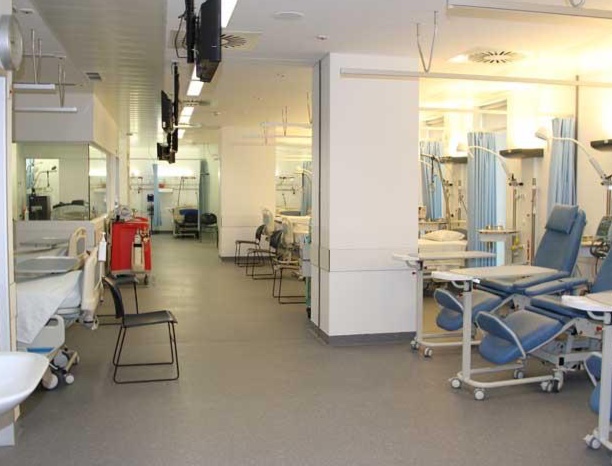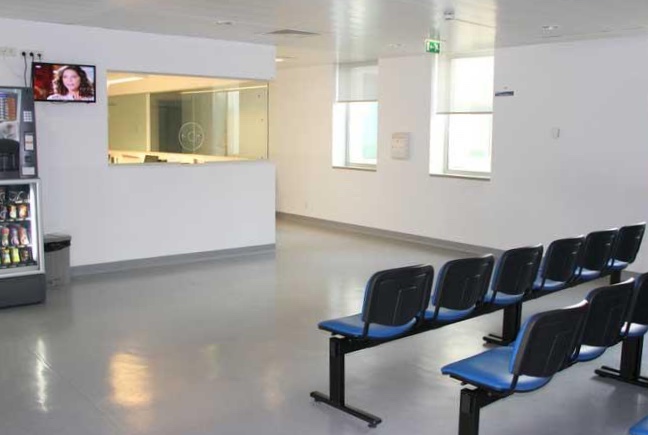Coincidentally, that morning I checked my position on the waiting list for my inguinal hernia operation: number 58. So I was very surprised when, in the afternoon, someone phoned me from the hospital in Lamego. Whether I could come for the operation the following week?
Okay…

What are hospitals like in Portugal?
It was not as bad as I feared. In the Netherlands, I only had surgery once, so I don’t really have much comparative material. The big difference, of course, is that in the Netherlands I understand everything and everyone, so I felt less insecure and less vulnerable there.
Another thing I find special is that Dutch hospitals feel like meeting places. With a grand entry hall with kiosks, coffee shops or restaurants. With cosy seating areas where patients can receive their visitors, with nice planters. This is not the case in the public hospitals I saw in Portugal. In them, it is far from cosy.
In fact, during the period when I underwent surgery, it was chaos at the emergency stations in Portuguese cities. The low point being the death of a 1-month-old baby in a waiting ambulance. There is a huge shortage of staff, with hospitals unable to cope with the flow of patients. A friend told me that her Granddad had had to wait three days in the emergency room in Porto before a doctor could examine him. Fortunately, he had been offered a bed. But it had been horrendous, she said.
( all the more reason to be careful in traffic, on construction sites, in the garden and around the house, because the emergency room is the last place you want to end up in Portugal)
In contrast, public hospitals performed a record number of operations in the second half of 2022. The highest number since 2013. And I was one of them.
Surgery in Lamego
The hospital in Lamego is quite small and only since 2021 have they been performing ambulatory procedures. It is part of the larger hospital in Vila Real.
On the day of the surgery, I had to be present in the early afternoon.
We took a seat in the waiting room of the ambulatory clinic, where we had to wait until I was called. By then, I was assigned a locker in the waiting room and had to follow the nurse. She gave me a bag for my clothes and surgical garments: paper pants, a shirt, slippers, a hairnet and a paper blanket.
She then put my personal belongings in the locker. I myself had to wait with the other patients in a sitting area in the corridor.
One by one, we were sent to a small room, where no fewer than five people assailed me. One had to go through a questionnaire with me, another had to measure my heart rate and blood pressure, another had to apply the infusion coupler and the others I don’t remember. This was all done in Portuguese!
Back in the corridor half an hour later, the anaesthetist joined me. She advised me an epidural anaesthetic and gave the reasons why. She, fortunately, spoke English so I could check if I had understood it all correctly. She was quite insistent and I agreed to the epidural.
A little after that, it was my turn. The nurse took my reading glasses and book to my locker. I was given some fluid through an IV and then allowed to proceed to the operating room. As I walked in, I got a little upset. I felt like a lamb being taken to the slaughter. The anaesthetist was there for me. After she reassured me, I said I really preferred general anaesthesia. That was no problem and the last thing I felt was her gently stroking my temple.

An hour later, I was woken up and had to wait a good hour and a half before being discharged. I was given a bag of painkillers and instructions. And then Nuno was allowed to take me home. After a good first night’s sleep, I was far from feeling bad, but quite sore.
Meanwhile, the wound has healed nicely. At the local health centre, they changed the bandage and checked the wound during the first few weeks. They also took out the stitches. Not until a few weeks from now will I have to go for a check-up with the surgeon, whom I have not seen at all so far!
In preparation for this report, I found a report by the TV channel SIC on the ambulatory unit in Lamego. In it, all the rooms I stayed in can be seen. Kind of an absurd idea, since I was out half the time. But I survived. And with a bit of luck, I will be able to fully stand my ground on the scaffold again this year.
Useful link
If you are registered with Portuguese Public Health, you can log in to a personal page using this link:
Área Pessoal do SNS24 – Login
You can request an appointment with your GP there, ask for a repeat prescription and, like me, see what your position is on the waiting list, among other things.
Here you can read how we registered with Portuguese Public Health: registering for healthcare
And about the prelude to surgery: a bit off-colour

